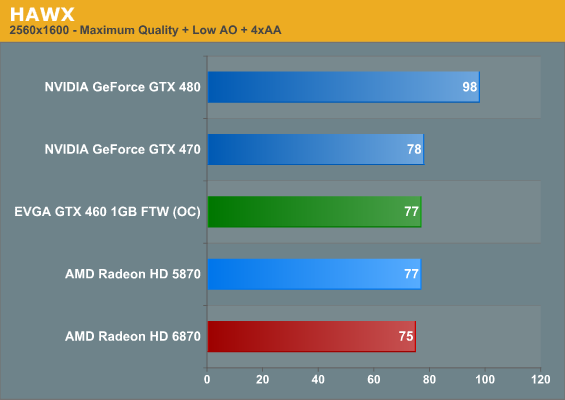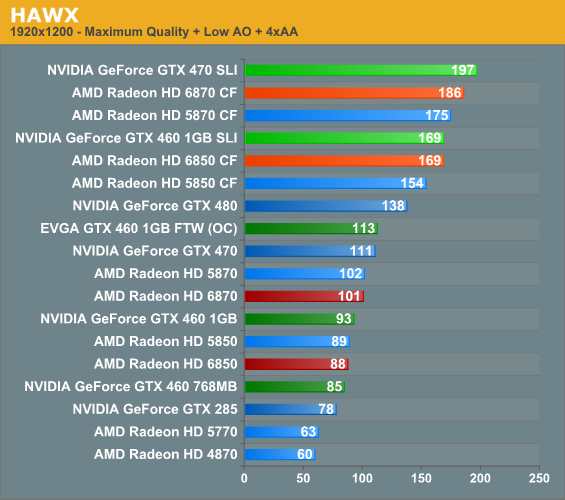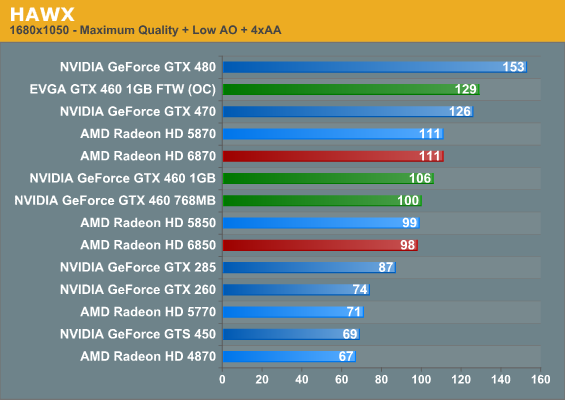AMD’s Radeon HD 6870 & 6850: Renewing Competition in the Mid-Range Market
by Ryan Smith on October 21, 2010 10:08 PM ESTUbisoft’s 2008 aerial action game is one of the less demanding games in our benchmark suite, particularly for the latest generation of cards. However it’s fairly unique in that it’s one of the few flying games of any kind that comes with a proper benchmark.



Unlike our previous shader-bound games, HAWX is a game that’s light on the shaders and comparatively heavier on geometry, texturing, and general rasterization. As a result it’s one of the best games for the Barts architecture, as the 6800 series comes out only a frame behind their 5800 series counterparts thanks to the equal number of ROPs and the higher clockspeeds of the 6800 series. In this game at least, 6800 and 5800 are equals.
Unfortunately for AMD, both generations may be equal, but compared to NVIDIA they’re equally slow. The EVGA GTX 460 and the GTX 470 enjoy a healthy 10% lead over the 5870/6870, while the 6850 has more in common with the GTX 460 768MB than it does the GTX 460 1GB.
Meanwhile in an action that blows our mind, the 6800 series cards in Crossfire manage to convincingly beat the 5800 series in Crossfire. Admittedly we’re talking about a difference that’s academic (169fps vs 154fps) but it’s as clear a sign as any that something special is going on with the 6800 series in Crossfire.










197 Comments
View All Comments
Targon - Thursday, October 21, 2010 - link
Since the 6870 can not beat the 5870, shouldn't AMD leave the 5870 on the market until they have a true replacement ready? Price vs. Performance is one thing, but dropping their high end parts and replacing them with mid-range cards($200ish) just doesn't have the "Wow!" factor that helps drive sales across the price ranges.Jansen - Thursday, October 21, 2010 - link
That would be the 6900 series next month:http://www.dailytech.com/Radeon+6800+Series+Launch...
Kyanzes - Friday, October 22, 2010 - link
Just to be on the safe side I'd like to see minimum FPS results. Although there's very little doubt in my mind that it underperforms.animekenji - Saturday, December 25, 2010 - link
It doesn't underperform. HD6970 replaces HD5870. HD6870 will be replacing HD5770, which it vastly outperforms. What about the new numbering scheme don't you get?Onyx2291 - Thursday, October 21, 2010 - link
If I had a job and the money, one of these would be on it's way to my house right now.Doctor_Possum - Thursday, November 11, 2010 - link
One of these is on it's way to my house right now. Can't wait.Onyx2291 - Thursday, December 22, 2011 - link
Over a year later, and one is now on it's way to my house right now :DRasterman - Thursday, October 21, 2010 - link
Ok nVidia, ATI, Intel, enough with the shitty naming of your devices, a 5870 beats a 6870? Really? I mean come on! Really? Create a committee to agree on a group of benchmarks the result of which is what you get to name your card. Score 100, you now have the Radeon 100, score 340, you now have a GeForce 340.Fleeb - Friday, October 22, 2010 - link
Though I must agree with you, AMD gave a reason why they did that (marketing perspective) - they are not going to drop 5770 and 5750 yet but replace 5870 and 5850 with 6970 and 6950. Perhaps everything will go back to normal again in the 7xxx series.bennyg - Saturday, October 23, 2010 - link
Maybe if it were something like 6810 and 6830 there wouldn't be so many complaints.But the wider issue is the quasi-quantitative naming schemes in general, they'll never be a perfectly accurate representation of "performance" (or "value for money" or whatever other metric that every individual buyer interprets it to be)
There'll never be any standard like that, marketing needs wiggle-room that independently-derived pure numbers do not provide. So they'll never agree to it.